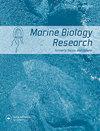Low genetic diversity and lack of genetic structure among populations of the sandfish Holothuria (Metriatyla) scabra on the Tanzanian coast
IF 1.2
4区 生物学
Q4 ECOLOGY
引用次数: 1
Abstract
ABSTRACT The tropical sandfish Holothuria (Metriatyla) scabra Jaeger, 1833 has been severely depleted in the Western Indian Ocean because it is easy to catch and in high demand. In response, Mainland Tanzania closed the fishery; however, the fishery remains open in the semi-autonomous islands of Zanzibar. Yet, it is unknown whether the aforementioned contrasting management measures are consistent with the genetic stock structure of the fishery. Therefore, this study analysed partial sequences (706 base pairs) of the cytochrome oxidase subunit I gene (COI) from four sandfish populations from Tanzania to assess the extent of genetic diversity and population structure. The populations showed low haplotype (0.17–0.44) and nucleotide diversities (0.025–0.084%), as well as small mutation-scaled effective size (9 × 10−4−17 × 10−4) compared to other marine macroinvertebrates from Tanzania, suggesting that the fishery has not recovered despite the ban that was imposed 16 years ago. Furthermore, Analysis of Molecular Variance (AMOVA) revealed a low and non-significant genetic differentiation index (F ST = 0.0047, p > 0.05), indicating a lack of population structure. The lack of population structure was further supported by phylogenetic analysis, which grouped together all COI haplotypes of sandfishes from both Zanzibar and Mainland Tanzania. This suggests that populations in Mainland Tanzania and Zanzibar are genetically homogeneous and that Zanzibari fishers may be targeting the same stock that is protected in Mainland Tanzania. Therefore, the fishery should be managed as a single unit and management measures between Mainland Tanzania and Zanzibar should be harmonized.坦桑尼亚海岸沙鱼Holothuria(Metriatyla)scabra种群遗传多样性低且缺乏遗传结构
摘要热带沙鱼Holothuria(Metriatyla)scabra Jaeger,1833在西印度洋已经严重枯竭,因为它很容易捕获,需求量很大。作为回应,坦桑尼亚大陆关闭了渔业;然而,桑给巴尔半自治岛屿的渔业仍然开放。然而,尚不清楚上述对比管理措施是否与渔业的遗传种群结构一致。因此,本研究分析了坦桑尼亚四个沙鱼种群的细胞色素氧化酶亚基I基因(COI)的部分序列(706个碱基对),以评估遗传多样性和种群结构。这些群体显示出较低的单倍型(0.17–0.44)和核苷酸多样性(0.025–0.084%),以及较小的突变规模有效大小(9 × 10−4−17 × 10−4)与坦桑尼亚的其他海洋大型无脊椎动物相比,这表明尽管16年前实施了禁令,但渔业仍未恢复。此外,分子方差分析(AMOVA)显示了低且不显著的遗传分化指数(F ST = 0.0047,p > 0.05),表明缺乏种群结构。种群结构的缺乏得到了系统发育分析的进一步支持,该分析将桑给巴尔和坦桑尼亚大陆的沙鱼的所有COI单倍型组合在一起。这表明坦桑尼亚大陆和桑给巴尔的种群在基因上是同质的,桑给巴尔渔民可能瞄准了坦桑尼亚大陆受保护的同一种群。因此,渔业应作为一个单一的单位进行管理,坦桑尼亚大陆和桑给巴尔之间的管理措施应协调一致。
本文章由计算机程序翻译,如有差异,请以英文原文为准。
求助全文
约1分钟内获得全文
求助全文
来源期刊

Marine Biology Research
生物-海洋与淡水生物学
CiteScore
2.10
自引率
0.00%
发文量
55
审稿时长
6-12 weeks
期刊介绍:
Marine Biology Research (MBRJ) provides a worldwide forum for key information, ideas and discussion on all areas of marine biology and biological oceanography. Founded in 2005 as a merger of two Scandinavian journals, Sarsia and Ophelia, MBRJ is based today at the Institute of Marine Research, Bergen, Norway. The Journal’s scope encompasses basic and applied research from all oceans and marine habitats and on all marine organisms, the main criterium for acceptance being quality.
 求助内容:
求助内容: 应助结果提醒方式:
应助结果提醒方式:


